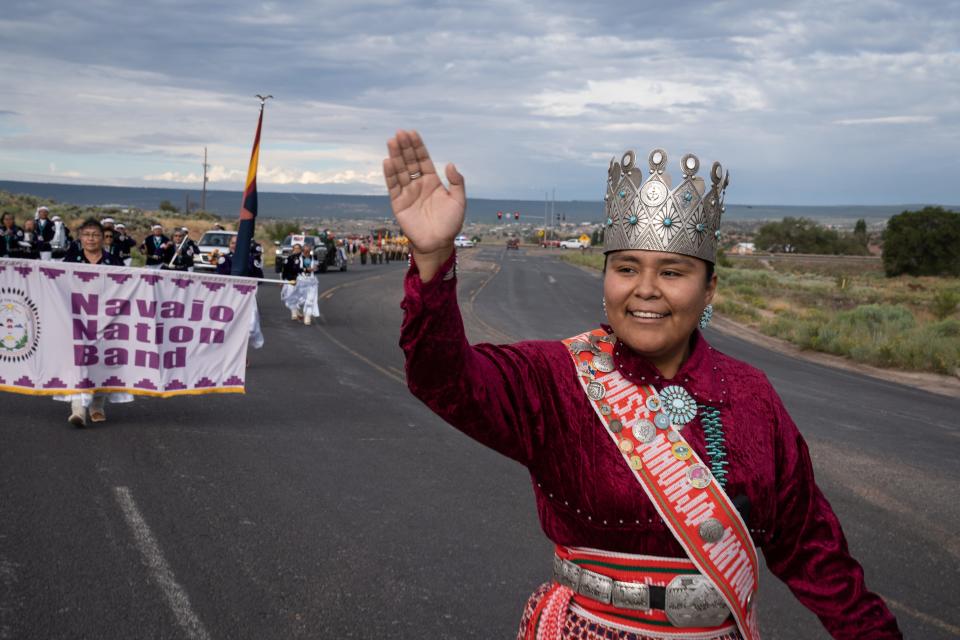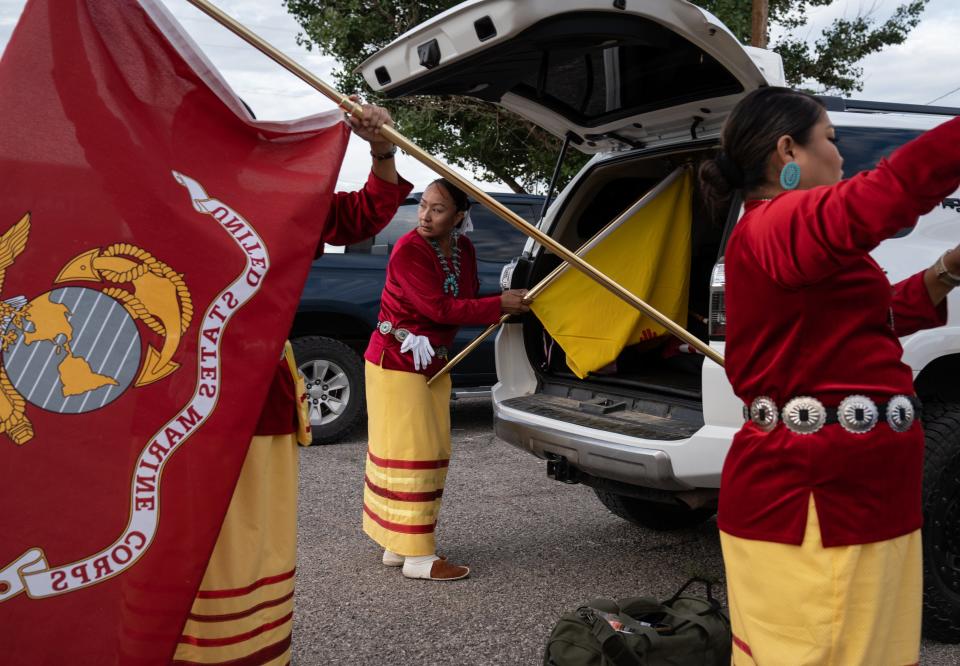On Navajo Code Talker Day, families preserve the legacies of men who helped win WWII
WINDOW ROCK — It took Larry Foster 20 years to thoroughly research the history of the Navajo Code Talkers, an elite set of Diné Marines who used their language to create the famous unbreakable code that helped win critical battles during World War II.
His father, Navajo Code Talker Harold Foster, from Sheep Springs, was the driving force behind the research and to this day, nearly 30 years after his father’s passing, Foster continues to remember him and share the history of this turbulent time for his dad and between 375 and 420 other young Diné men.
Foster and other descendants of Navajo Code Talkers come together every Aug. 14 at the Window Rock Tribal Park and Veterans Memorial to honor and share stories. In 1982, Navajo Code Talkers Day was established through a presidential proclamation by President Ronald Reagan. In 2020, Arizona Gov. Doug Ducey signed legislation to make National Navajo Code Talkers Day a state holiday.
“The Holy People developed that language and they brought it to our homelands,” said Foster. “That language stuck with them (Code Talkers), and they brought it to the battlefield because the United States Marine Corps couldn't fight without a code. Our language is still here today. That is important.”
The annual parade was at the center of events Monday in the Navajo Nation capital, along with an honor run by NavajoYES, a welcome address, other speakers, descendants exhibits and gourd dancing.
Tents were pitched in the parking lot between Window Rock Tribal Park and Veteran's Memorial and the Navajo Nation President's Office. Visitors walked through the tents, occupied by the family of Navajo Code Talkers, looked at the photos and talked with the descendants, who are now the holders of the stories they were told by the Code Talkers in their family.
In the bigger tent, the crowd listened to the Navajo Nation Band perform and heard speakers including President Buu Nygren, Navajo Speaker Crystalyne Curley and other dignitaries.
Only one surviving Code Talker attends the Window Rock event
What was an event where Navajo Code Talkers would dress in their signature corn pollen-colored velveteen shirts and red hats has dwindled because so many of these great men have died. This year, former tribal chairman and Navajo Code Talker Peter MacDonald attended, but the other two surviving Code Talkers, Thomas Begay and John Kinsel Sr., did not make the event.
“It’s sad,” said Teddy Draper III, whose dad was the late Navajo Code Talker Teddy Draper, Sr., about the passing of Navajo Code Talkers. “Everyone is gone. I’ve seen them when they were young. I’ve always been close with them.”
Draper returned to the event for the first time this year since 2018, setting up his dad’s tent with photos. He recalled how, in 1975 his dad, along with other Navajo Code Talkers, marched in the Rose Bowl Parade in Pasadena, Calif., and all of them took turns carrying young Draper.
“They all carried me through that," Draper said. "I’m in those photos. I was just a little baby.”
Like his father, Draper enlisted in the Marines, but it wasn’t because of his dad’s enlistment. He signed up after the bombing of the World Trade Center in 2001. His dad wanted to enlist after the bombing of Pearl Harbor in 1941, but he was still underage at that point in time and had to wait an extra two years, his son said.
“He was trying to get to the Air Force,” said Draper. “He went to boot camp and didn’t know he was going to get into this program until after boot camp. He thought he was in trouble because they were taking him to headquarters.”
Foster said his dad was also underage when he enlisted at 17. Because his father was in boarding school at Fort Wingate, he saw the first 29 Navajo Code Talkers deploy for boot camp, and this piqued his interest to enlist.

In a huge binder full of documents and pictures, Foster pointed to a consent form to allow his father to join the Marines. His grandparents, Sam and Ann Foster, both placed their thumbprint to consent for their young son to join the Marines, and a community member and a medicine man signed the consent as witnesses.
"Back during the days they wanted young men to participate," said Foster. "A Navajo Nation resolution was developed saying it was OK for young men to volunteer. He didn't finish high school. He went to the 11th grade. He went to boot camp on Oct. 2, 1942. They found out he was Navajo, so they sent him to Navajo Code Talker school."
'I continue to share his legacy'

More than half a century after her father George B. Willie Sr. served as a Navajo Code Talker, Annabelle Smallcanyon sang the Marine Corps Hymn in Navajo to kick off Flagstaff's event honoring her father and his fellow Code Talkers.
After the Code Talker operation was declassified in 1968, Willie, Sr., like many others, remained hesitant to speak about his service, and it took years for his family to learn about his role in WWII.
"Our father was a very humble man," Smallcanyon said.
It wasn't until her son was tasked with writing about a veteran for an assignment in elementary school that the family started asking for more details about Willie, Sr.'s experience and learned that he was a Code Talker. Eventually Willie, Sr., became more willing to talk about his service, but any information about his past would come out in bits and pieces, Smallcanyon said. She took to keeping a notepad with her to jot down the stories her father decided to tell.
"My father was very quiet, humble, (he) didn't speak much but was very loving and was very kind," she said.
Smallcanyon recounted numerous stories her father shared with her, including why he originally enlisted. After learning about the attack on Pearl Harbor in 1941, he and his friends, still just teenagers at the time, all enlisted in the Marine Corps. While they all signed up, Willie, Sr., was the only one eligible for service.
"'I was just following them and here, I had to go,'" Smallcanyon remembers him joking.
Eventually, Smallcanyon said, Willie, Sr., reconnected with his fellow Code Talkers in numerous gatherings over the years, a meaningful community for her father who had grown up an orphan.
At their first meeting, Smallcanyon said, there were more than 50 Code Talkers all in one place. Today, only three are still living.
"Today, he's not here with us but I continue to share his legacy — their legacy — and that's an honor for me," she said.
Code Talker families still hope a museum will be built
In Window Rock, Herbert Goodluck, son of the late Navajo Code Talker John Goodluck, uses this week to teach the history of the Navajo Code Talkers and his dad by way of ham radio. His call name on the radio is November 7 Hotel Golf, and he said he enjoys connecting with people from all over the country and the world.
At his booth every year at the Window Rock Code Talker event, Herbert speaks of how his dad specialized in communications during the war. He even has replicas of the type of radio his dad would've used while oversees in combat.
"He was in the second wave," said Goodluck, who's from Lukachukai. "Most of the time he was on the island and broadcasting from the battleships. Just imagine bullets flying, bombs going off, and you had to concentrate on the communication. First, you would receive it in Navajo and then you would have to translate it to English and you had a high ranking official looking over you."
About 10 families continue to attend the Navajo Code Talker event to share the life and legacy of their Navajo Code Talker. For years, there has been discussion of building a Navajo Code Talker museum, but lack of funding has always prevented the attempts.
There is a small museum at the Burger King in Kayenta, and a Japanese photographer who has spent decades photographing the famous veterans, Kenji Kawano, has his Navajo Code Talkers exhibit on display at the Navajo Nation Museum.
Last year's Navajo Code Talker event marked the groundbreaking ceremony of the National Code Talker Museum in Tsé Bonito, N.M. In 2019, the Navajo Nation received over $1 million to assist with the design and construction of the museum from New Mexico, but not much has happened since the groundbreaking.
Curley said the 25th Navajo Nation Council supports a museum and there have been some donations, but funding again continues to be a factor. Until a museum is built, it will be left to the descendants like Foster, Draper, and Goodluck to continue on telling the history of the important historical figures known as Navajo Code Talkers.
"We want to welcome each and everyone of you for making it out here to spend sometime and remembrance to those brave Navajo Coe Talkers," said Nygren during the Navajo Code Talker event.
Arlyssa Becenti covers Indigenous affairs for The Arizona Republic and azcentral. Send ideas and tips to arlyssa.becenti@arizonarepublic.com.
Support local journalism. Subscribe to azcentral.com today.
This article originally appeared on Arizona Republic: Navajo Code Talker Day brings together families of veterans

